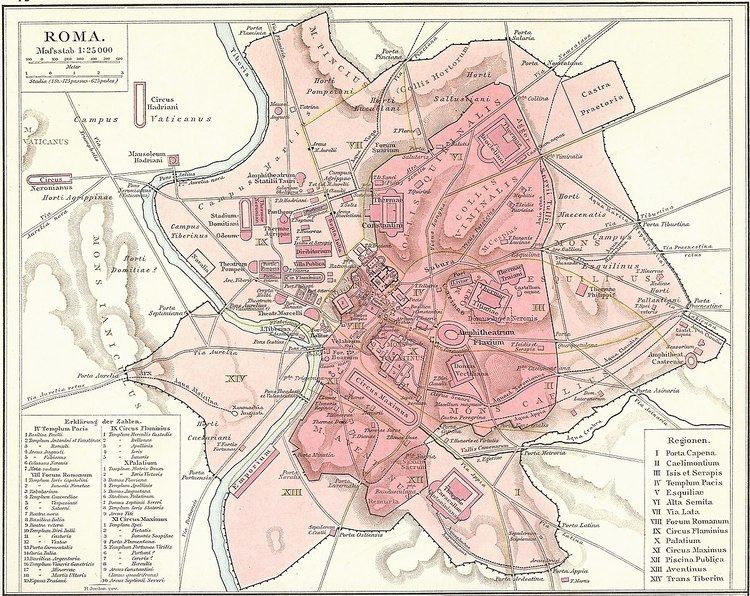Built in Inauguration 20 BC Related | ||
 | ||
Similar Umbilicus urbis Romae, Lacus Curtius, Basilica Julia, Shrine of Venus Cloacina, Column of Phocas | ||
Milliarium aureum column of phocas septimius severus arch tempel of vespasian and titus in rom
The Milliarium Aureum ([miːllɪˈaːrɪʊm ˈawrɛʊm], Golden Milestone; Italian: Miliario Aureo) was a monument, probably of marble or gilded bronze, erected by the Emperor Caesar Augustus near the Temple of Saturn in the central Forum of Ancient Rome. All roads were considered to begin at this monument and all distances in the Roman Empire were measured relative to it. On it perhaps were listed all the major cities in the empire and distances to them, though the monument's precise location and inscription remain matters of debate among historians.
Contents
- Milliarium aureum column of phocas septimius severus arch tempel of vespasian and titus in rom
- Milliarium aureum
- History
- Architecture and style
- Location
- Style structure and dimensions
- The problem of the inscription
- The problem of the marble fragments labeled Milliarium Aureum
- References
According to Schaff, the phrase "all roads lead to Rome" is a reference to the Milliarium Aureum - the specific point to which all roads were said to lead. Today, a marble structure speculated to be the base of the milestone is present in the Roman Forum.
Milliarium aureum
History
Augustus, as curator viarum, erected the monument in 20 BC. It probably received the name Milliarium Aureum soon after its inauguration. It symbolized the starting point of the Roman road system to the rest of Italy and to all the imperial possessions.
Architecture and style
The plan of the monument is among those missing from the recovered fragments of the Forma Urbis. The remaining fragments for this area of the Roman Forum are all in the so-called slab V-11, Stanford University #19 (Temple of Saturn with the frontal section and staircase, but the Rostra section is missing, Temple of Concordia, and Temple of the Deified Vespasian). Information from ancient authors is also very scarce, so there are many problems of interpretation concerning the exact nature of the Milliarium Aureum.
Location
It is certain that it was "hard by [under] the Temple of Saturn at the head of the Roman Forum", but its exact location is still unknown. Due to archaeological data from excavations by Kähler in 1959, which seem to confirm data from excavations by Bunsen in 1833, many scholars now believe that it was located at the southeast corner of the podium of the Rostra Augusti on a symmetrical axis with the Umbilicus Urbis Romae.
Style, structure, and dimensions
The Milliarium Aureum seems to have been a marble column sheathed in gilded bronze; according to C. Hülsen, a huge marble cylinder was found in 1835 near the Temple of Saturn and it still had bronze hooks. The whole monument likely had the standard form of a Roman milestone. Some scholars think that the Milliarium Aureum was made entirely of gilded bronze, while others believe only the inscribed letters were gilded bronze. Probable dimensions for the structure include a height of 370 centimetres (150 in), and a diameter of 1.15 metres (3.8 ft) (column only) or 3 metres (9.8 ft) if including the alleged base (i.e. the carved marble fragments labeled "Milliarium Aureum" in the Roman Forum).
The problem of the inscription
Ancient sources never directly say what was inscribed on the Milliarium Aureum, so every idea one may have about the inscription must be considered a modern inference based on the typical form, structure and function of Roman milestones.
The main hypotheses about the inscription suggest that it included:
The problem of the marble fragments labeled "Milliarium Aureum"
The ca. 3-m diameter marble fragments labeled "Milliarium Aureum" with an anthemion frieze decoration have long been considered part of the base of the monument. However, there is no direct evidence for this, considering as well that the diameter of this base seems to be too large for a standard milliarium.
According to Richardson, the ruins labeled "Milliarium Aureum" can be considered pertinent only if the column of the monument was of a colossal scale, of almost 3 m diameter and not 1.15 m:
Still less credible is that the carved stone members labelled Milliarium Aureum at the northwest end of the Forum Romanum today actually belonged to the base of that monument. The frieze decorated with an anthemion belongs relatively high on a building, and both elements are of a diameter equal to that of the Umbilicus Romae, too large for a milestone, unless it were of colossal scale.
Scholars now prefer to consider these fragments a section of the upper part of the Umbilicus Urbis Romae ("Navel of the City of Rome"), a structure in the same area of the Forum which served a similar but not identical purpose, and which had a base 5.1 m in diameter and upper elements 3 m in diameter.
